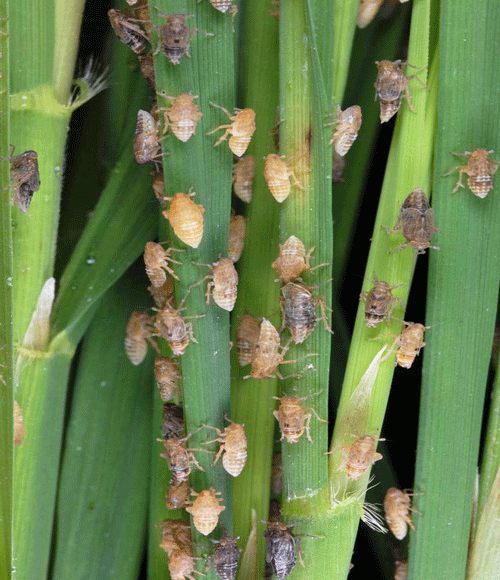Chickpea, also known as gram or Bengal gram, is a significant legume crop cultivated in many parts o ...
The Brown Plant Hopper (BPH), scientifically known as Nilaparvata lugens, is one of the most notorious pests affecting rice crops worldwide. This tiny insect, measuring only about 3-4 mm in length, can cause extensive damage to rice plants, leading to significant yield losses. The BPH is particularly destructive in Asia, where rice is a staple food, making its management crucial for food security.
ब्राउन प्लांट हॉपर धान की फसल के लिए एक प्रमुख कीट है, जिसे वैज्ञानिक भाषा में Nilaparvata lugens कहा जाता है। यह कीट विशेष रूप से दक्षिण और दक्षिण-पूर्व एशिया के धान उत्पादक क्षेत्रों में गंभीर समस्या बन चुका है। यह कीट धान के पौधों से रस चूसकर उनकी वृद्धि और उत्पादन को प्रभावित करता है, जिससे किसान भाईयों को भारी नुकसान उठाना पड़ता है।
ब्राउन प्लांट हॉपर के शरीर का रंग हल्का भूरा होता है। वयस्क कीट के पंख पारदर्शी होते हैं और वे उड़ने में सक्षम होते हैं। इस कीट के नवजात (निम्फ) का रंग हल्का पीला होता है, जो बाद में भूरे रंग में परिवर्तित हो जाता है।

BPH धान के पौधों के तनों से रस चूसकर पौधे को कमजोर कर देता है। इसके कारण पौधा पीला और सूख जाता है, जिसे 'हॉपर बर्न' कहा जाता है। यदि यह कीट खेत में अनियंत्रित रह जाए, तो फसल पूरी तरह से बर्बाद हो सकती है। इसके अलावा, यह कीट धान के पौधों में वायरस जनित रोगों के प्रसार का कारण भी बनता है, जो और भी गंभीर स्थिति पैदा कर सकता है।
BPH का जीवन चक्र अंडा, निम्फ और वयस्क तीन अवस्थाओं में पूरा होता है। अंडे का समय 7-10 दिन का होता है। निम्फ अवस्था में यह कीट 15-20 दिनों तक रहता है, जिसके बाद यह वयस्क बनता है। जीवन चक्र की पूरी अवधि लगभग 25-30 दिन की होती है।
1. प्राकृतिक उपाय: धान के खेतों में पानी का उचित प्रबंधन BPH की रोकथाम में मददगार होता है। इसके अलावा, रोपाई की उचित दूरी और पौधों की स्वस्थ वृद्धि के लिए उचित खाद का उपयोग करना भी आवश्यक है।
2. रासायनिक नियंत्रण: गंभीर स्थिति में, कीटनाशकों का प्रयोग करना पड़ता है। लेकिन इसका इस्तेमाल करने से पहले स्थानीय कृषि विशेषज्ञ की सलाह अवश्य लें, ताकि वातावरण और फसल पर इसके प्रभाव को कम किया जा सके।
3. जैविक नियंत्रण: BPH के प्राकृतिक दुश्मनों जैसे मकड़ियाँ, शिकारी कीड़े और परजीवी ततैया का उपयोग करके भी इस कीट को नियंत्रित किया जा सकता है। यह विधि पर्यावरण के लिए सुरक्षित होती है और फसल को भी कम नुकसान पहुंचाती है।

ब्राउन प्लांट हॉपर धान की खेती के लिए एक गंभीर चुनौती है, लेकिन सही समय पर उपाय और सावधानी बरतने से इस कीट पर नियंत्रण पाया जा सकता है। किसान भाईयों को नियमित रूप से खेतों का निरीक्षण करना चाहिए और किसी भी प्रकार की असामान्य स्थिति को नजरअंदाज नहीं करना चाहिए। इस तरह, वे अपनी फसल को सुरक्षित रख सकते हैं और अच्छी पैदावार प्राप्त कर सकते हैं।
Effective management of BPH requires an integrated approach that combines cultural, biological, and chemical methods.
1. Cultural Practices:
- Balanced Fertilization: Avoid excessive use of nitrogen fertilizers. Employ balanced fertilization strategies to promote healthy plant growth without making the plants too attractive to BPH.
- Water Management: Maintain proper water levels in the fields. Periodic draining of fields can disrupt the life cycle of BPH and reduce nymph survival.
- Planting Time: Adjusting the planting time to avoid peak BPH population periods can help minimize damage.
2. Biological Control:
- Natural Enemies: Encourage the presence of natural predators and parasites of BPH, such as spiders, lady beetles, and parasitic wasps. These biological control agents can significantly reduce BPH populations.
- Pathogens: Fungal pathogens like *Beauveria bassiana* can be introduced into the fields to infect and kill BPH nymphs and adults.
3. Chemical Control:
- Insecticides: Use of insecticides should be carefully managed to avoid the development of resistance in BPH populations. Systemic insecticides, which are absorbed by the plant and kill the hoppers as they feed, can be effective, but their use should be minimized and integrated with other control methods.
- Resistant Varieties: Planting BPH-resistant rice varieties can be an effective strategy, but it should be part of a broader Integrated Pest Management (IPM) approach to prevent the development of new BPH biotypes.
4. Monitoring and Early Detection:
- Regular monitoring of rice fields for early signs of BPH infestation is crucial. The use of light traps and pheromone traps can help in detecting BPH populations at an early stage, allowing for timely intervention.
0
0
Chickpea, also known as gram or Bengal gram, is a significant legume crop cultivated in many parts o ...
Mango is one of the most popular and widely cultivated fruits globally. However, mango trees are sus ...
Jhulsaa Rog, commonly known as "Blast Disease," is a significant threat to rice crops worldwide. Thi ...
Rice is a staple food for a large portion of the world's population, making its cultivation crucial ...
Rice (paddy) is one of the most vital staple crops in the world, feeding billions of people globally ...
Wheat is a staple crop grown globally, but it is susceptible to various diseases that can significan ...
Gardeners and farmers often rely on chemical pesticides to protect their plants from pests and disea ...